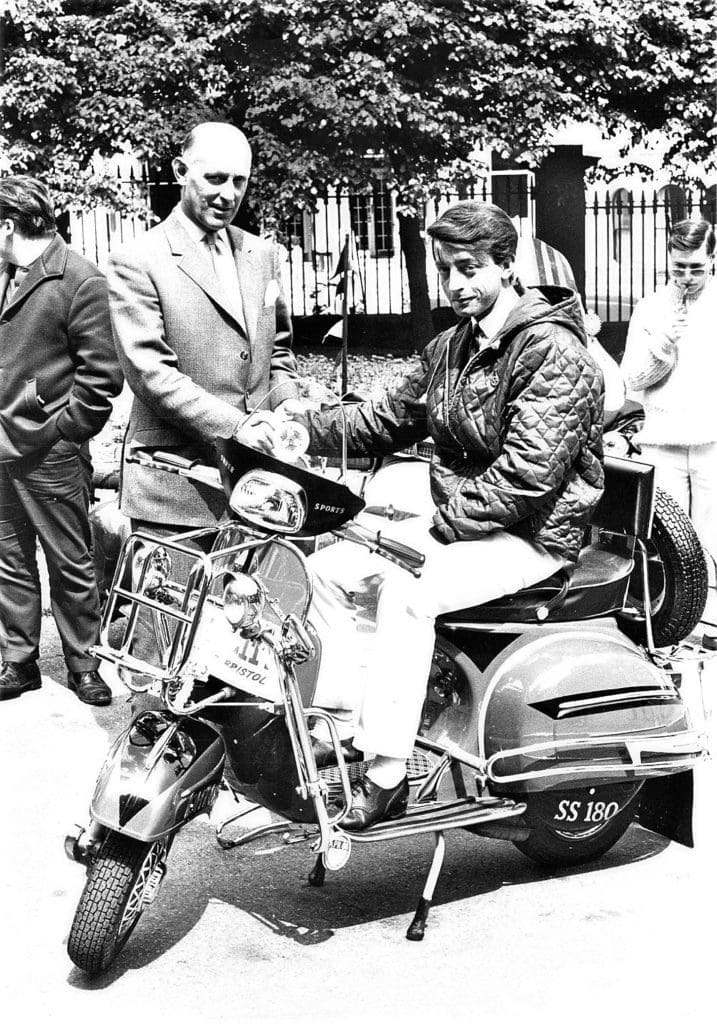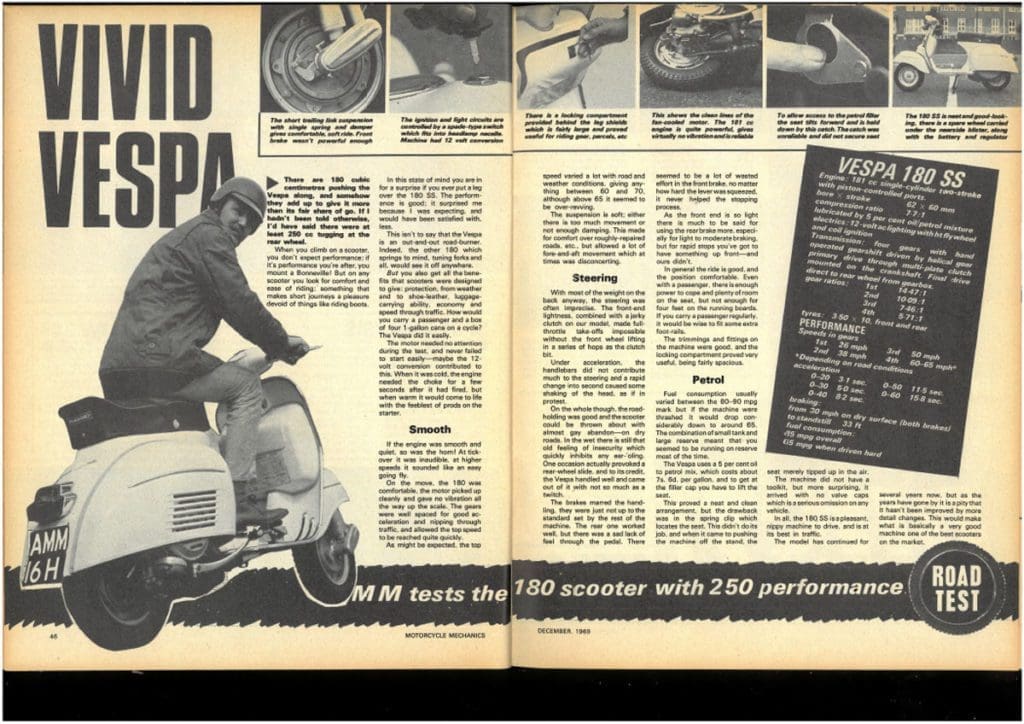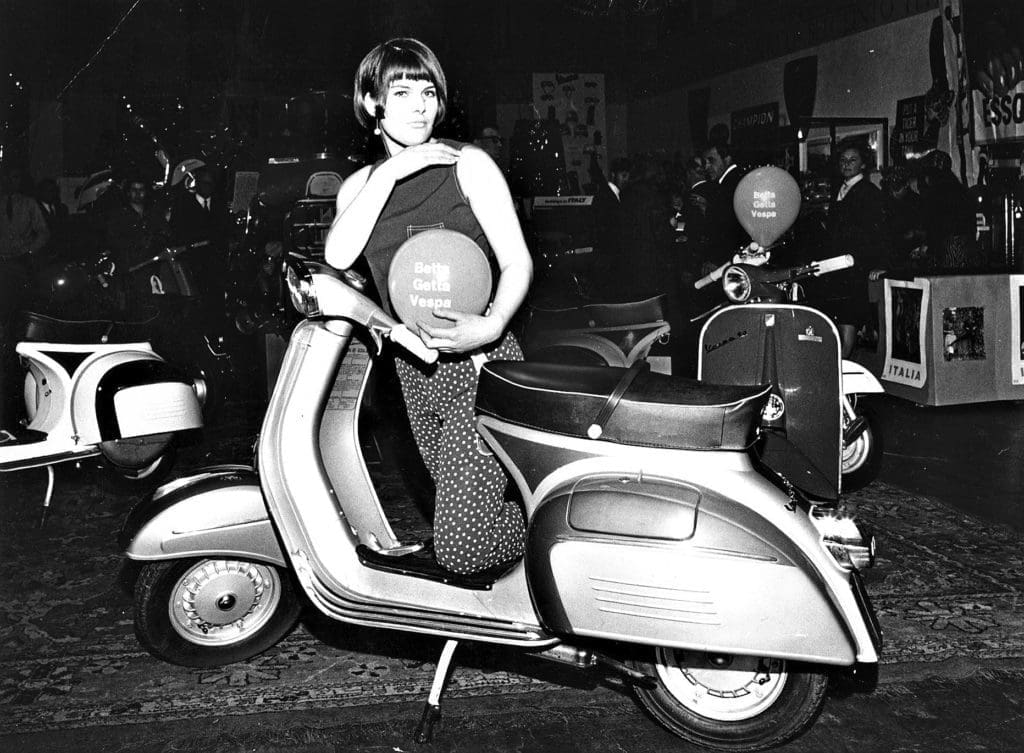When Motorcycle Mechanics reviewed the SS180 in 1969 it was at the end of its production life, yet the reviewer still found plenty to praise.
Vivid Vespa
There are 180 cubic centimetres pushing the Vespa along, and somehow they add up to give it more than its fair share of go. If I hadn’t been told otherwise I’d have said there were at least 250cc tugging at the rear wheel.
When you climb on a scooter you don’t expect performance; if it’s performance you’re after you mount a Bonneville! But on any scooter you look for comfort and ease of riding; something that makes short journeys a pleasure devoid of things like riding boots. In this state of mind you are in for a surprise if you ever put a leg over the 180. The performance is good, it surprised me because I was expecting, and would have been satisfied with, less.
This isn’t to say that the Vespa is an out-and-out road-burner. Indeed, the other 180 which springs to mind, tuning forks and all, would see it off anywhere.
But you also get the benefits that scooters were designed to give; protection from weather and to shoe-leather, luggage carrying ability, economy and speed through traffic. How would you carry a passenger and a box of one gallon cans on a cycle? The Vespa did it easily.
The motor needed no attention during the test, and never failed to start easily, maybe the 12 volt conversion contributed to this. When it was cold, the engine needed the choke for a few seconds after it had fired, but when warm it would come to life with the feeblest of prods on the starter.

Smooth
If the engine was smooth and quiet, so was the horn! At tickover it was inaudible, at higher speeds it sounded like an easy going fly.
On the move, the 180 was comfortable, the motor picked up cleanly and gave no vibration all the way up the scale. The gears were well spaced for good acceleration and nipping through traffic and allowed top speed to be reached quite quickly.
As might be expected, the top speed varied a lot with road and weather conditions, giving anything between 60 and 70, although above 65 it seemed to be over-revving. The suspension is soft; either there is too much movement or not enough damping. This made for comfort over roughly repaired roads etc, but allowed a lot of fore-and-aft movement which at times was disconcerting.

Steering
With most of the weight on the back anyway, the steering was often imprecise. The front-end lightness, combined with a jerky clutch on our model, made full throttle take-offs impossible without the front wheel lifting in a series of hops as the clutch bit.
Under acceleration, the handlebars did not contribute much to the steering and a rapid change into second caused some shaking of the head, as if in protest.
On the whole though the road-holding was good and the scooter could be thrown about with gay abandon – on dry roads. In the wet there is still that old feeling of insecurity which quickly inhibits any ear-‘oling. One occasion actually provoked a rear-wheel slide, and to its credit the Vespa handled well and came out of it with not so much as a twitch.
The brakes marred the handling, they were just not up to the standard set by the rest of the machine. The rear one worked well, but there was a sad lack of feel through the pedal. There seemed to be a lot of wasted effort in the front brake, no matter how hard the lever was squeezed, it never helped the stopping process.
As the front end is so light there is much to be said for using the rear brake more, especially for light to moderate braking, but for rapid stops you’ve got to have something up front – and ours didn’t. In general the ride is good, and the position comfortable.
Even with a passenger, there is enough power to cope and plenty of room on the seat but not enough for four feet on the running boards. If you carry a passenger regularly, it would be wise to fit some extra foot rails.
The trimmings and fittings on the machine were good, and the locking compartment proved very useful, being fairly spacious.

Petrol
Fuel consumption usually varied between the 80-90mpg mark but if the machine were thrashed it would drop considerably down to around 65. The combination of small tank and large reserve meant that you seemed to be running on reserve most of the time.
The Vespa uses a 5% oil to petrol mix, which costs about 7s 6d per gallon, and to get at the filler cap you have to lift the seat. This proved a neat and clean arrangement, but the drawback was in the spring clip which locates the seat. This didn’t do its job, and when it came to pushing the machine off the stand, the seat merely tipped up in the air.
The machine did not have a tool kit, but more surprising it arrived with no valve caps which is a serious omission on any vehicle.
In all the SS180 is a pleasant, nippy machine to drive, and is at its best in traffic. The model has continued for several years now, but as the years have gone by it is a pity that it hasn’t been improved by more detail changes.
This would make what is basically a very good machine one of the best scooters on the market.
SS180: The ABC
Model: Vespa 180 Super Sport (VSC1T).
Launched: Milan Show 1964.
Production total: 35,700.
Engine
Displacement: 181.1cc.
Bore x stroke: 62x60mm.
Compression ratio: 8:1.
Power/revs: 10bhp @6250rpm.
Carburettor: Dell’Orto SI-27/23 (23mm).
Dimensions
Length: 1770mm.
Width: 690mm.
Saddle height: 810mm.
Wheelbase: 1230mm.
Wheels: 3.50×10 front and rear.
Brakes: 150mm drum front and rear.
Tank capacity: 9 litres.
Weight: 105kg.
Maximum speed: 65mph



